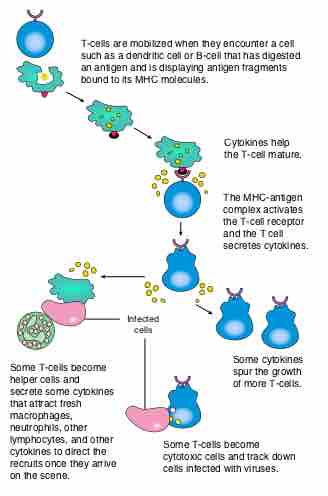Cellular immunity is mediated by T lymphocytes, also called T cells. Their name refers to the organ from which they're produced: the thymus. This type of immunity promotes the destruction of microbes residing in phagocytes, or the killing of infected cells to eliminate reservoirs of infection. T cells do not produce antibody molecules. They have antigen receptors that are structurally related to antibodies. These structures help recognize antigens only in the form of peptides displayed on the surface of antigen-presenting cells.
T cells consist of functionally distinct populations. These include naive T cells that recognize antigens and are activated in peripheral lymphoid organs. This activation results in the expansion of the antigen-specific lymphocyte pool and the differentiation of these cells into effector and memory cells. Effector cells include helper T cells, and cytolytic or cytotoxic T cells. In response to antigenic stimulation, helper T cells (characterized by the expression of CD4 marker on their surface) secrete proteins called cytokines, whose function is to stimulate the proliferation and differentiation of the T cells themselves, as well as other cells, including B cells, macrophages, and other leukocytes. Cytolytic or cytotoxic T cells (characterized by the expression of CD8 marker on their surface) kill cells that produce foreign antigens, such as cells infected by viruses and other intracellular microbes .

Cell-mediated immunity
T cells promote the killing of cells that have ingested microorganisms and present foreign antigens on their surface.
Memory T cells are an expanded population of T cells specific for antigens that can respond rapidly to subsequent encounter with that antigen and differentiate into effector cell to eliminate the antigen. Another class of T cells called regulatory T cells function to inhibit immune response and resolve inflammation. Their major role is to shut down T cell-mediated immunity toward the end of an immune reaction.